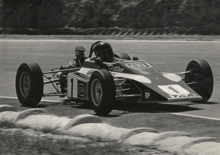Bowin P6
The Bowin P6 is a racing car that was designed and built in Australia in 1973 by Bowin for the Formula Ford & Australian Formula 2 categories.[1]
Specifications

The chassis was a space frame built to full 2-litre specifications, with alloy-stressed panels and finished in stove enamel. It incorporated a fully detachable rear cross beam to facilitate engine maintenance, permitting removal of the engine and gearbox as one unit. The body was a full aerodynamic wedge, incorporating side radiators. The interior of the cockpit was covered in fully moulded seat and trim sections, making it exceptionally comfortable and roomy.
The rear suspension incorporated twin radius arms, parallel links, Armstrong adjustable dampers, and fully adjustable spherical bearings throughout. The front suspension was a double-wide-based wishbone design, with Armstrong adjustable dampers and fully adjustable spherical bearings throughout. The coil spring units for both front and rear were mounted inboard with "Bowin variable rate spring control".
The P6 was steered by a lightweight rack and pinion designed by Bowin, with an energy absorbing steering column surmounted by a leather-covered steering wheel. It had 9.75 in (24.8 cm) disc brakes with alloy caliper assemblies. The twin braking system was adjustable for length and had an adjustable-ratio balance control. The rear brakes were mounted inboard on the gearbox to reduce unsprung weight. The wheels were magnesium, with 10 in × 13 in (25 cm × 33 cm) in front and 12 in × 13 in (30 cm × 33 cm) or 14 in × 13 in (36 cm × 33 cm) in the rear.
It had a wheelbase of 93 in (240 cm), a track of 61 (front) and 63 (rear), and a weight of 822 lb (373 kg) with twin cam engine.
The transmission was a Hewland FT2000, providing five speeds and reverse, and it had an alloy adaptor plate. The hydraulic clutch system was complete, up to and including the release mechanism on the gearbox.
The engine was water-cooled by twin, cross-flow, lightweight, side-mounted radiators, with a deaireator control tank and pressure cap. The alloy oil tank was fitted with antisurge baffles, a deaireator system, alloy pipes, hoses and fittings, and an alloy oil cooler. Fuel was contained in alloy tanks mounted in the midsection of the car for better weight distribution. The P6 was supplied with engine mountings.
The electrical system was powered by a 12 volt, lightweight, aircraft battery, which had a master battery control. It powered a starter solenoid via starter button and switches, as well as an array of instruments, including tachometer (0–10,000 rpm), oil pressure, water temperature, and oil temperature.
All suspension parts were finished in new Bowin satin finish, and the other parts were cadium plated and stove enamelled. The body was painted in a colour of the customer's choice.
Options for the P6 were:
- cam-adjustable magnesium rack and pinion
- integral P.8 Magnesium front upright and hollow rotating drive shafts on roller bearings
- stainless steel brake hoses
- wings
References
- Pedr Davis, The Macquarie Dictionary of Motoring, 1986, page 54